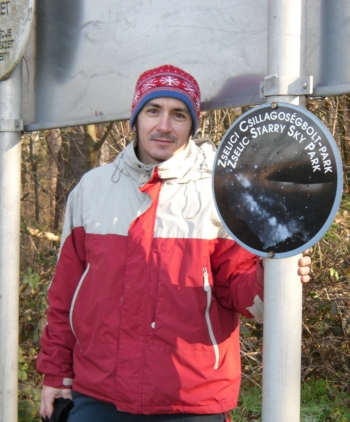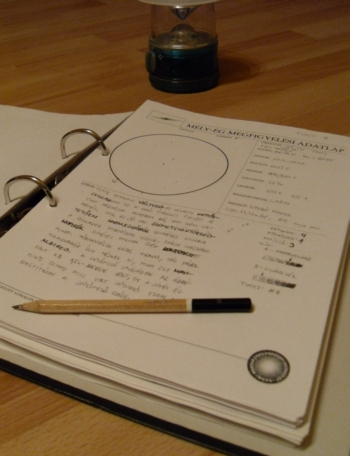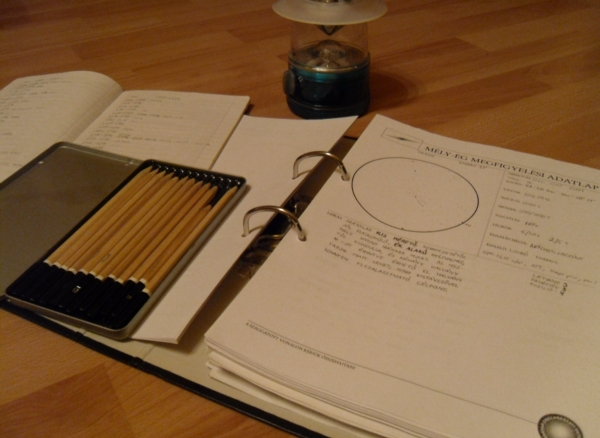|
About me
|
 Hi, this page is about me, the guy behind these observations. I'm Ferenc Lovró, an amateur astronomer from Nádasdladány, Hungary. I've been interested in astronomy from my early childhood, I clearly remember that once I've noticed an interesting triplet of stars on a line on the sky, and that hooked me to the love of the heavens forever. I now know that that was the belt of Orion. I've just started school when I've read a book titled Sky and Earth (Ég és Föld) that I still have on my bookshelf. It was a fantastic read, and all my thoughts and imagination were about stars from that time on. Somehow I was always more like a theory kid, read lots of books about stellar phenomena, planets, constellations, instruments, and although I've got a small Russian 10x30 monocular from my dad, I rarely used it, the conditions just weren't favorable enough, and of course I always had to go to bed too early.
Hi, this page is about me, the guy behind these observations. I'm Ferenc Lovró, an amateur astronomer from Nádasdladány, Hungary. I've been interested in astronomy from my early childhood, I clearly remember that once I've noticed an interesting triplet of stars on a line on the sky, and that hooked me to the love of the heavens forever. I now know that that was the belt of Orion. I've just started school when I've read a book titled Sky and Earth (Ég és Föld) that I still have on my bookshelf. It was a fantastic read, and all my thoughts and imagination were about stars from that time on. Somehow I was always more like a theory kid, read lots of books about stellar phenomena, planets, constellations, instruments, and although I've got a small Russian 10x30 monocular from my dad, I rarely used it, the conditions just weren't favorable enough, and of course I always had to go to bed too early.
I've grown up like that, reading about astronomy most of my time, and looking at images of stars, nebulae and galaxies on the Internet as soon as I was able to surf it in 1994. And although I knew what the HRD was when I was just a 6th grader, and I knew about things like stable orbits around binary stars or fusion, supernovae, galactic types, quasars and so on, I was still only reading about the sky, and enjoyed the view only with my bare eyes.
But after I got a job with a decent salary, I realized that now I can enjoy more hobbies at the same, and I don't need to choose between them. By this time we've moved from our city flat to the suburbs of a 100k city, into a house with a nice dark garden, so I've soon find myself buying my first real telescope, a 114/900 Newtonian. I was able to observe most of the planets with my new scope, but soon I've found that my sky is not as dark as I thought it is, and I was able to view only a few deep sky objects, mostly open clusters. Actually I didn't even know what collimation is, so many years laters I was shocked when I first checked the optics of this scope: it was totally out of collimation. The other bottleneck that prevented me from proper use of this telescope was the terrible eyepieces that were included with it. Of course I've only found how bad they were after I've bought a new telescope and bought a couple of fine eyepieces.
So back in 2006 I've joined the Hungarian Astronomical Association (Magyar Csillagászati Egyesület), and I've started to read about actual observations done by fellow amateurs. I've seen what kind of telescopes and other equipment they used and this made me want to give practical astronomy another chance. In 2007 we've moved with my love to a new house I currently live in, and suddenly I found myself under REALLY great dark skies. The number of stars were more than what I've ever seen, the Milkyway was visible instantly, and the sky background was really black. I've made a decision: I need a better telescope to get the most out of this great sky. I was lurking forums, seeking advice, and found that for my main interest - deep sky and minor planets - I'll need something really big. I thought this should be a 200mm reflector, but one day an interesting ad appeared in one of the astro-classifieds website: someone was selling a barely used 300mm Dobsonian for the price of a new 200mm telescope, and more to that, a great Baader Hyperion eyepiece was also included in the price. So a few days later I was driving home with my new telescope in the back of the car, and I was the happiest guy that day. And what a huge instrument that was!
I remember, that I had such a big quest to find M13 with my old 114/900 under the light-polluted skies of the suburbs, and when I finaly found it, it was just a very faint, featureless spot. Now M13 was the first object I pointed my new telescope to, and I was able to find it in less than a minute, and I was shocked by the image: the whole globular cluster was huge, bright and fully resolved to individual stars. What a difference that was!
 I was hooked to the sky on every clear nights from then on, and observed many objects I was once reading about. "Observed" is actually not the right word... I was rather just rushing, taking a glimpse for a few seconds and then on to the next object. So a month later I was looking at a galaxy, and suddenly I had a really bad feeling in me: there's that wonderful object in my eyepiece, hosting billions of worlds, and maybe on some of these worlds, a little guy is looking through his telescope and observing our Milky way, and thinking about what if on one of these worlds someone is looking at him. That someone was me. And I felt really bad, because there were plenty of wonders in front of me, and I was ignoring them by not using enough time to see and understand of what's in the eyepiece. So from then on, I decided to take my time to really observe everything, by spending lots of time with a single object. I've soon found that the best tool to force myself to spend that time is to sketch the object. A single sketch takes about 30-90 minutes, sometimes more, sometimes less, but about 60 minutes is an average.
I was hooked to the sky on every clear nights from then on, and observed many objects I was once reading about. "Observed" is actually not the right word... I was rather just rushing, taking a glimpse for a few seconds and then on to the next object. So a month later I was looking at a galaxy, and suddenly I had a really bad feeling in me: there's that wonderful object in my eyepiece, hosting billions of worlds, and maybe on some of these worlds, a little guy is looking through his telescope and observing our Milky way, and thinking about what if on one of these worlds someone is looking at him. That someone was me. And I felt really bad, because there were plenty of wonders in front of me, and I was ignoring them by not using enough time to see and understand of what's in the eyepiece. So from then on, I decided to take my time to really observe everything, by spending lots of time with a single object. I've soon found that the best tool to force myself to spend that time is to sketch the object. A single sketch takes about 30-90 minutes, sometimes more, sometimes less, but about 60 minutes is an average.
Sketching did not only taught me how to observe an object, but also how I can see more and more details with every minute I spend at the eyepiece. My vision quickly became better: my naked eye limiting magnitude increased with about 1-1.5 magnitudes in a year or two, and I was able to catch really faint details that seemed impossible before.
So that's how it all started.
I've since bought and built several other astronomical instruments, most of them you'll see on these pages. In 2012 we've bought a little cottage in the Zselic Landscape Protection area in Southwest Hungary and brought my old 114/900 telescope there. Of course now it is well collimated, has adequate eyepieces and guess what: under the dark Zselic skies the little scope resolves M13... Something I've never dreamed of. So if you have some cheap telescope and can't get much out of it, remember my experience: all you need to set it up properly, go under great dark skies and most importantly get lots of experience. This three combined will make miracles.
Now I'm almost only interested in deep-sky objects, found that my love for minor planets will need some even larger aperture. But I have many plans for the future and many projects I'd like to make. I'd like to sketch all the NGC objects visible from the Northern Hemisphere. I've found another interesting and somewhat unusual project: to observe and catalog the most colourful stars on the sky. These should keep me busy for a few years. For the next decade I also have a plan to build a huge, 50-60cm Nasmyth telescope for the dome observatory that I'll soon finish constructing.
Thanks for reading my story, hope you'll enjoy my observations as much as I do making them.
PS.: I'm not a member on any social websites such as Facebook, Google+, etc, and will never be. I'm not commenting videos on YouTube or anywhere else. The only site I'm active on are Cloudy Nights, as "starquake". So in case you find "me" somewhere else, that's not me.

|
|
|

